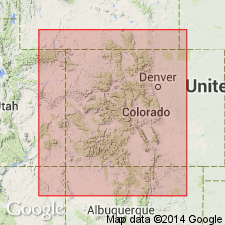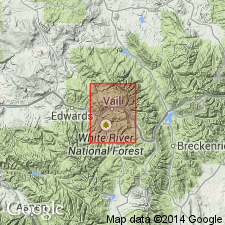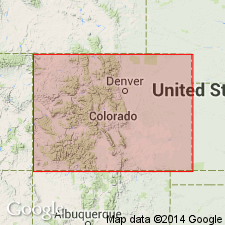
- Usage in publication:
-
- Cross Creek Granite*
- Modifications:
-
- Overview
- AAPG geologic province:
-
- Southern Rocky Mountain region
Summary:
In a batholithic body in northern Sawatch Range, Pitkin Co and Gore Range, Routt Co, CO in Southern Rocky Mountain region, mapped previously as "granite of Cross Creek." Listed with granitic rocks of circa 1,700 m.y. (Precambrian X) age group.
Source: GNU records (USGS DDS-6; Denver GNULEX).

- Usage in publication:
-
- Cross Creek Granite*
- Modifications:
-
- Named
- Dominant lithology:
-
- Quartz monzonite
- AAPG geologic province:
-
- Southern Rocky Mountain region
Summary:
Named for exposures on Cross Creek (its type area), north end of Sawatch Range, southwest corner of Minturn quad, Eagle and Summit Cos, CO in Southern Rocky Mountain region, its type area. Is inferred to be one batholith. Forms an area of about 50 sq mi in northern end of Sawatch Range and forms bulk of Gore Range. Is typically a medium- to coarse-grained, irregularly porphyritic, gray to pinkish-gray, slightly to markedly foliated quartz monzonite. Most of the rock is gneissic but some is structureless. Is characterized by abundant inclusions of partly granitized gneiss or migmatite which can be only a few inches across to many sq mi across. Is locally a breccia of gneiss fragments a few inches to several feet in diameter in a matrix of granite. Resembles the Boulder Creek Granite in composition and occurrence. A 6 point Rb-Sr isochron gave an age of 1.71 m.y., or Precambrian X age assigned. Geologic map.
Source: GNU records (USGS DDS-6; Denver GNULEX).

- Usage in publication:
-
- Cross Creek Quartz Monzonite*
- Modifications:
-
- Redescribed
- Overview
- Dominant lithology:
-
- Quartz monzonite
- AAPG geologic province:
-
- Southern Rocky Mountain region
Summary:
Is one of nine formally named lithodemic units assigned to Early Proterozoic Routt Plutonic Suite (new name). Redescribed--name changed from Cross Creek Granite to Cross Creek Quartz Monzonite. Is exposed in Gore and Sawatch Ranges, CO, Southern Rocky Mountain region. Is part of Cross Creek batholith, which is about 60 km (40 mi) long in the Eagle basin. Is a gray to pink-gray, medium- to coarse-grained quartz monzonite that is slightly to markedly foliated, irregularly porphyritic and intimately associated with migmatites. Is about 1,675 m.y. (Rb-Sr) old, the same age as Denny Creek Granodiorite.
Source: GNU records (USGS DDS-6; Denver GNULEX).
For more information, please contact Nancy Stamm, Geologic Names Committee Secretary.
Asterisk (*) indicates published by U.S. Geological Survey authors.
"No current usage" (†) implies that a name has been abandoned or has fallen into disuse. Former usage and, if known, replacement name given in parentheses ( ).
Slash (/) indicates name conflicts with nomenclatural guidelines (CSN, 1933; ACSN, 1961, 1970; NACSN, 1983, 2005, 2021). May be explained within brackets ([ ]).

